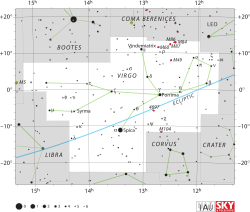Epsilon Virginis
| Observation data Epoch J2000.0 Equinox J2000.0 |
|
|---|---|
| Constellation | Virgo |
| Right ascension | 13h 02m 10.59785s |
| Declination | +10° 57′ 32.9415″ |
| Apparent magnitude (V) | +2.826 |
| Characteristics | |
| Spectral type | G8 III |
| U−B color index | +0.718 |
| B−V color index | +0.940 |
| Astrometry | |
| Radial velocity (Rv) | -14.6 km/s |
| Proper motion (μ) |
RA: -273.80 mas/yr Dec.: +19.96 mas/yr |
| Parallax (π) | 29.76 ± 0.14mas |
| Distance | 109.6 ± 0.5 ly (33.6 ± 0.2 pc) |
| Absolute magnitude (MV) | 0.37 ± 0.06 |
| Details | |
| Mass | 2.64 ± 0.11 M☉ |
| Radius | 10.6 ± 0.3 R☉ |
| Luminosity | 77 L☉ |
| Surface gravity (log g) | 2.71 ± 0.04 cgs |
| Temperature | 5,086 K |
| Metallicity [Fe/H] | +0.09 dex |
| Rotation | 173 days |
| Rotational velocity (v sin i) | 2.3 km/s |
| Age | 560 ± 90 Myr |
| Other designations | |
Epsilon Virginis (ε Virginis, abbreviated Epsilon Vir, ε Vir), also named Vindemiatrix, is a star in the zodiac constellation of Virgo. The apparent visual magnitude of this star is +2.8, making it the third-brightest member of Virgo. Based upon parallax measurements made during the Hipparcos mission, Vindemiatrix lies at a distance of about 109.6 light-years (33.6 parsecs) from the Sun, give or take a half light-year.
Vindemiatrix is a giant star with a stellar classification of G8 III. With 2.6 times the mass of the Sun, it has reached a stage in its evolution where the hydrogen fuel in its core is exhausted. As a result, it has expanded to over ten times the Sun's girth and is now radiating around 77 times as much luminosity as the Sun. This energy is being emitted from its outer atmosphere at an effective temperature of 5,086 K, which gives it the yellow-hued glow of a G-type star. Since 1943, the spectrum of this star has served as one of the stable anchor points by which other stars are classified.
This star is a likely member of the thin disk population and the orbit departs by no more than 60 pc (200 ly) from the galactic plane.
ε Virginis (Latinised to Epsilon Virginis) is the star's Bayer designation.
...
Wikipedia

